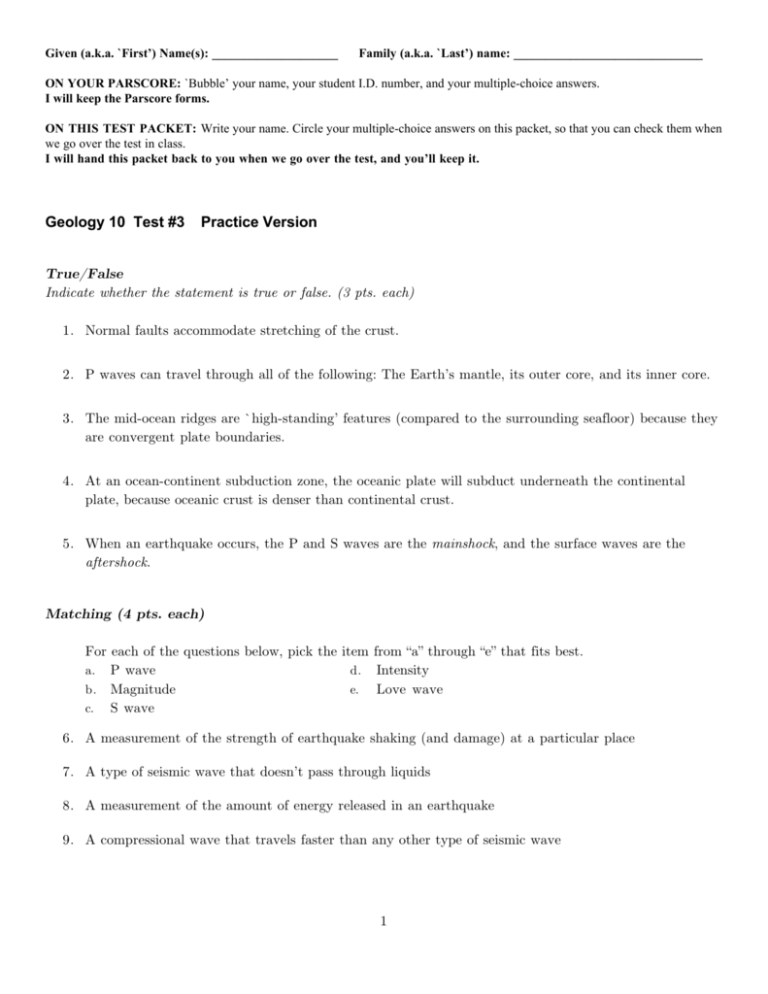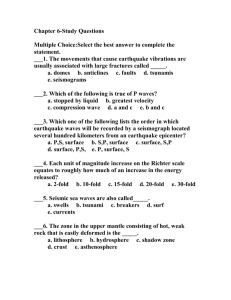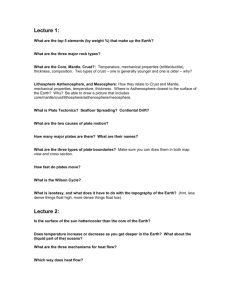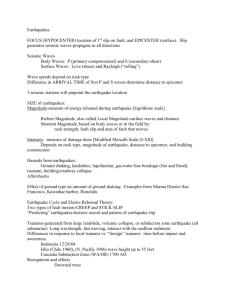Geology 10 Test #3 Practice Version
advertisement

Given (a.k.a. `First’) Name(s): ____________________ Family (a.k.a. `Last’) name: ______________________________ ON YOUR PARSCORE: `Bubble’ your name, your student I.D. number, and your multiple-choice answers. I will keep the Parscore forms. ON THIS TEST PACKET: Write your name. Circle your multiple-choice answers on this packet, so that you can check them when we go over the test in class. I will hand this packet back to you when we go over the test, and you’ll keep it. Geology 10 Test #3 Practice Version True/False Indicate whether the statement is true or false. (3 pts. each) 1. Normal faults accommodate stretching of the crust. 2. P waves can travel through all of the following: The Earth’s mantle, its outer core, and its inner core. 3. The mid-ocean ridges are `high-standing’ features (compared to the surrounding seafloor) because they are convergent plate boundaries. 4. At an ocean-continent subduction zone, the oceanic plate will subduct underneath the continental plate, because oceanic crust is denser than continental crust. 5. When an earthquake occurs, the P and S waves are the mainshock, and the surface waves are the aftershock. Matching (4 pts. each) For each of the questions below, pick the item from “a” through “e” that fits best. a. P wave d. Intensity b. Magnitude e. Love wave c. S wave 6. A measurement of the strength of earthquake shaking (and damage) at a particular place 7. A type of seismic wave that doesn’t pass through liquids 8. A measurement of the amount of energy released in an earthquake 9. A compressional wave that travels faster than any other type of seismic wave 1 Multiple Choice - General Knowledge Choose the ONE best answer and mark it on your Parscore form. (5 pts. each) 10. If you found an *ophiolite* in a mountain range somewhere, what would the ophiolite represent? a. A stack of lava flows that formed at a continental-margin volcanic arc. b. An ancient piece of continental crust that's found within an oceanic plate. c. A piece of the sub-continental mantle that's been exposed at the Earth's surface. d. A portion of the oceanic crust that got caught up in convergent-boundary processes. 11. What’s the difference between a joint and a fault? a. A fault shows measurable displacement between its two sides, whereas a joint doesn’t. b. Faults are formed during crustal shortening, whereas joints are formed during crustal stretching. c. A fault is a joint with a great length, generally more than 1 km long. d. In a joint, the hanging wall has moved up with respect to the footwall, whereas in a fault, it’s the other way around. 12. Which of the following is the correct order of arrivals of seismic waves from an earthquake? a. S waves, P waves, surface waves b. P waves, S waves, surface waves c. Surface waves, S waves, P waves d. Surface waves, P waves, S waves 13. Which of these things causes the bending of the paths of seismic waves as they pass through the earth? a. The increase in the speed of the waves with depth b. The fact that the speed of the waves doesn’t change with depth c. The decrease in the speed of the waves with depth d. The presence of a liquid-iron outer core in the earth 14. Along which type of plate boundary will NEITHER plate subduct to a significant depth? a. A transform plate boundary b. An ocean-continent subduction zone c. A continent-continent collision zone d. An ocean-ocean subduction zone 2 15. As plates move away from each other at a divergent boundary, why doesn’t the underlying asthenosphere get exposed and become visible at the Earth’s surface? a. Divergent boundaries quickly become convergent ones, covering the asthenosphere with newly-formed mountain ranges. b. Decompression melting causes eruptions and intrusions to form new crust. c. Rapid deposition of thousands of feet of sediment covers the asthenosphere. d. The asthenosphere is not present underneath divergent plate boundaries. 16. Imagine that we collect paleomagnetic data from rocks of many different ages on a number of different continents. If we compare the apparent polar-wander paths from these continents, and we find that they only agree for very recent times, what does that mean? a. The Earth's magnetic field was split into several overlapping fields, and only recently came to have just one north pole and one south pole. b. The continents have stayed in the same positions relative to each other, but the magnetic poles of the Earth have wandered. c. The continents have been moving, relative to each other. d. These paleomagnetic results are a good sign that a magnetic field reversal has recently happened. 17. [PRACTICE]Imagine you’re looking at the seismograms from a large earthquake, and from one of that earthquake’s aftershocks. Which of the following features will the aftershock have? a. P, S, and surface waves b. An S wave only c. P and S waves only d. A P wave only 18. Which of these types of fault would be LEAST likely to cause uplift of a mountain range? a. A normal fault b. A thrust fault c. A strike-slip fault d. A reverse fault 3 Multiple Choice - Deeper Thought These questions are just like the other multiple-choice questions, just a little harder. As before, choose the ONE best answer and mark it on your Parscore form. (7 pts. each) 19. While hiking through the Alps, you find yourself looking at an outcrop of gneiss. Upon looking closely at this rock, you see that it appears to have flowed, but without having melted. The original structures in the rock have been highly distorted, and new minerals have formed during the rock’s deformation. Where did this deformation probably take place? a. In the upper part of the Earth’s crust, just below the surface b. In the outer core c. In the middle and/or lower part of the crust d. In the inner core 20. Imagine a planet that is very much like the Earth, except that there is no variation in the speed of seismic waves inside the planet. Seismic body waves all move at the same speed, no matter where they are in the planet. Which of the following best describes what seismic ray paths would be like in this planet? a. The ray paths would not extend very far into the planet. b. The ray paths would be more curved than those in the Earth. c. The ray paths would be so curved that they would quickly bend back up to the surface before they got very far from the epicenter. d. The ray paths would all be straight. 21. Imagine you’re comparing two seismograms, one from an earthquake 100 km from your recording station, and the other from an earthquake 200 km from your recording station. Both earthquakes had the same magnitude. Which of the following best describes something that will be different between the two seismograms? a. The seismogram from the more distant earthquake will have a larger S-P lag time. b. The amplitude of the seismogram from the closer earthquake will be smaller. c. The seismogram from the closer earthquake will show a greater amount of time between the arrival of the P waves and the arrival of the S waves. d. The amplitude of the seismogram from the farther earthquake will be larger. 4 22. Imagine that you are held prisoner by an evil genius, who will set you free if you can figure out whether his secret underground lair is in one of the polar regions or inside a tropical volcano. You take the magnetized needle out of a compass, remove any weights that might be attached to it, and hang it at its balance point. It hangs almost exactly parallel to the ground. What does this tell you? a. The secret lair is deep underneath the Antarctic ice cap b. The secret lair is underneath Portland, Oregon, which is halfway between the equator and the north pole. c. The secret lair is on the planet Venus. d. The secret lair is inside a tropical volcano, near the equator. 23. Extra Credit: Imagine that you are a space alien who has been flying through the cosmos, and you encounter the Earth. Scanning it with your high-tech instruments, which allow you to examine both the land surface and the seafloor with ease, you notice that you are hovering over a volcano. Not only that, but it’s one of a number of volcanoes that lie along a curving line, and there’s a long, narrow, deep part of the ocean parallel to this line of volcanoes. Next, you release a number of remote seismic probes onto the Earth’s surface. Using them to map out the 3-D distribution of earthquakes within this part of the Earth, which of the following would you be most likely to find? a. An inclined zone of earthquakes that extends downward from the trench, and passes deep under the volcanoes. b. A vertical zone of earthquakes that extends downward from the volcanoes. c. An inclined zone of earthquakes that extends downward from the volcanoes, and passes deep under the trench. d. A vertical zone of earthquakes that runs at right angles to the trench. 5 Slide Section 24. (T/F) This image shows a reverse fault, and the person is standing on the hanging wall. 25. What type of fault is shown in this image? a. A normal fault b. A right-lateral strike-slip fault c. A reverse fault d. A left-lateral strike-slip fault 26. Imagine that you took this picture right before an earthquake occurred on this fault. (The earthquake is large enough to break the Earth’s surface along the trace of the fault.) If the person shown in the picture looked at you, what would they notice? a. You would be moved much closer to them, due to the fault motion. b. You would seem to have moved to their left, as they looked across the fault at you. c. You would seem to have moved to their right, as they looked across the fault at you. d. You would seem to move directly away from them, due to the fault motion. 6 27. Imagine that this drainage ditch had been built shortly before an earthquake that broke it. As strain energy built up before the next earthquake, why might people be unaware that this next earthquake was getting ready to happen? a. Both sides of the fault would be moving toward the same direction at the same speed, thus masking the buildup of strain energy. b. The distortion and bending of the rocks in this region would only be occurring in the deep part of the Earth’s mantle. c. This fault is part of a plate boundary, and each plate boundary only has one earthquake occur along it, and then the boundary becomes inactive. d. Although rocks are bending and distorting, the two sides of the fault are locked by friction, preventing any slippage here until the next earthquake. 28. (T/F) The wave arrival at “A” is the arrival of the compressional body waves (i.e. the P waves). 29. What can you determine from the amount of time that goes by between event “A” and event “B” on this seismogram? a. The earthquake’s magnitude b. The type of rock that broke during the earthquake c. The distance to the epicenter d. The depth of the earthquake 30. What is the physical meaning of distance “D”? a. It is a measurement of the stiffness of the rocks that broke during this earthquake. b. It is the maximum amount of ground motion recorded on this seismogram. c. It is the distance from the seismograph to the earthquake epicenter. d. It is the amplitude of the P wave. 7 31. Imagine that you examined another seismogram from this same earthquake, but recorded by a seismograph that was much farther from the `quake than the one that made this recording. What would be true about this second seismogram? a. The time gap between A and B would be the same, and measurement D would be much larger. b. The time gap between A and B would be larger, and measurement D would be smaller. c. The time gap between A and B would be the same, and so would measurement D. d. The time gap between A and B would be smaller, and measurement D would be larger. 32. (T/F) This map shows a plate boundary, and it is the narrow, deep trench at the edge of the ocean basin, right next to the continent. 33. Which of these places would be most likely to be the epicenter of a SHALLOW-focus earthquake? a. A b. B c. C d. D 34. Which of these places would be most likely to be the epicenter of a DEEP-focus earthquake? a. A b. B c. C d. D 8 35. Imagine you carried out a deep geophysical survey of the mountain range between points C and D. What would you be likely to discover about the crust in this region? a. The crust here has been drastically thinned due to divergent plate-boundary processes, and will soon become a mid-ocean ridge. b. The continental crust in this area is being transformed into oceanic crust. c. This is the site of an ongoing continent-continent collision. d. It has been thickened by shortening at this convergent boundary, and there is a deep crustal `root’ underneath the mountains. 36. (T/F) This image shows the positions of the continents today. 37. How does this image relate to Alfred Wegener’s hypothesis of continental drift? a. It shows the continents in their original positions, shortly after the Earth formed. b. It shows what the Earth’s continents would look like if the climate became much warmer, and the polar ice caps melted. c. It shows the continents in their modern-day positions, after the breakup of Pangea. d. It shows the supercontinent Pangea, which Wegener said existed in the late Paleozoic Era. 9 38. How does this image show one of Wegner’s lines of evidence for continental drift? a. This map shows the pattern of seafloor ages, and the relationship of this pattern to the locations of the mid-ocean ridges. b. The linear magnetic anomalies can be seen in the ocean surrounding Pangea. c. The large bay along the eastern edge of Pangea is the scar left behind by the giant impact that formed the Moon. d. Glacial deposits from the ice cap on the southern part of Pangea can be found on widely-separated continents today. 39. Imagine that this supercontinent were to undergo a breakup, starting several million years after the time depicted in this image. What sort of plate-tectonic features would form between the broken-up portions of the supercontinent, as they moved away from each other? a. Continental collision zones b. Ophiolites c. Deep-sea trenches d. Mid-ocean ridges 10 Geology 10 Winter 2014 Answer key for Test #3 PRACTICE VERSION 1 T 21 A 2 T 22 D 3 F 23 A 4 T 24 F 5 F 25 B 6 D 26 C 7 C 27 D 8 B 28 T 9 A 29 C 10 D 30 B 11 A 31 B 12 B 32 T 13 A 33 C 14 C (A, too) 34 D 15 B 35 D 16 C 36 F 17 A 37 D 18 C 38 D 19 C 39 D 20 D








